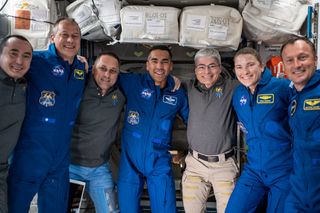Hear how NASA alerted astronauts to incoming space debris after Russian anti-satellite test
Expedition 66 woke up to take shelter in their return ships following a Russian anti-satellite test.
Newly released audio shows the quick scramble the Expedition 66 crew undertook to get to safety following an anti-satellite test on Monday (Nov. 15).
A Russian impactor was deliberately smashed into a defunct Soviet satellite, Cosmos 1408, causing a cloud of debris that came unexpectedly close to the International Space Station early that morning.
The audio features a conversation between NASA astronaut and flight engineer Mark Vande Hei, who is on his second long-term duration flight in space.
"Sorry for the early call," the unnamed ground controller says; it probably was a fellow astronaut, as capcoms (capsule communicators) are generally tasked with such duties. "We were recently informed of a satellite breakup," the controller continues, "and need to have you start reviewing the safe haven procedure."
Related: Space debris from Russian anti-satellite missile test spotted in telescope images and video

Within seconds, Vande Hei calmly returns the call and repeats back the instructions that ground control gives, to confirm the instructions and make sure that he heard them correctly. (This is standard operating procedure among astronauts and Mission Control during emergencies, to make sure instructions are understood.)
The audio shows that the crew was asked to implement "safe haven procedures," including moving to their return spacecraft and closing hatches to radial modules on the station. These hatches included Columbus, Kibo, the Permanent Multipurpose Module (aka Nauka), Bigelow Expandable Activity Module and Quest Joint Airlock, NASA said in a statement.
Get the Space.com Newsletter
Breaking space news, the latest updates on rocket launches, skywatching events and more!
Later in the audio, the crew is advised on what to do if a piece of debris hits the SpaceX Crew Dragon, which is the return craft for four of the seven crewmembers. Mission Control advises that if the spacecraft is hit, to return first to the ISS to await further instructions, which Vande Hei confirms.
The crew took shelter twice during the Monday morning event, which was later condemned by both the U.S. State Department and NASA administrator Bill Nelson, who said there will be a substantial additional risk to exploration in low Earth orbit. Both Roscosmos and the Russian government, conversely, have denied that the incident posed risk to the ISS.
Follow Elizabeth Howell on Twitter @howellspace. Follow us on Twitter @Spacedotcom and on Facebook.
Join our Space Forums to keep talking space on the latest missions, night sky and more! And if you have a news tip, correction or comment, let us know at: community@space.com.

Elizabeth Howell (she/her), Ph.D., is a staff writer in the spaceflight channel since 2022 covering diversity, education and gaming as well. She was contributing writer for Space.com for 10 years before joining full-time. Elizabeth's reporting includes multiple exclusives with the White House and Office of the Vice-President of the United States, an exclusive conversation with aspiring space tourist (and NSYNC bassist) Lance Bass, speaking several times with the International Space Station, witnessing five human spaceflight launches on two continents, flying parabolic, working inside a spacesuit, and participating in a simulated Mars mission. Her latest book, "Why Am I Taller?", is co-written with astronaut Dave Williams. Elizabeth holds a Ph.D. and M.Sc. in Space Studies from the University of North Dakota, a Bachelor of Journalism from Canada's Carleton University and a Bachelor of History from Canada's Athabasca University. Elizabeth is also a post-secondary instructor in communications and science at several institutions since 2015; her experience includes developing and teaching an astronomy course at Canada's Algonquin College (with Indigenous content as well) to more than 1,000 students since 2020. Elizabeth first got interested in space after watching the movie Apollo 13 in 1996, and still wants to be an astronaut someday. Mastodon: https://qoto.org/@howellspace
